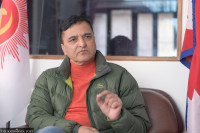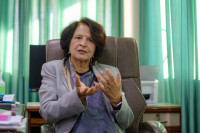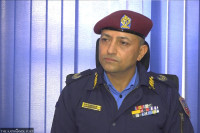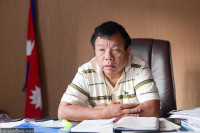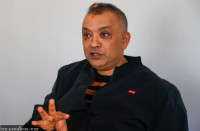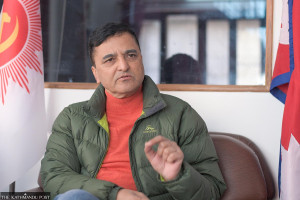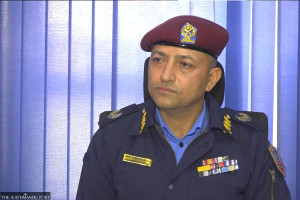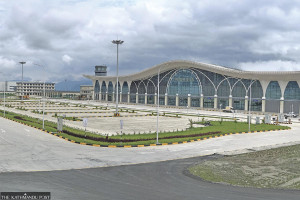Interviews
Timely government intervention prevented greater losses
We have not been able to integrate the latest technologies in our forecasting models. Our models are not updated to incorporate machine learning and Artificial Intelligence.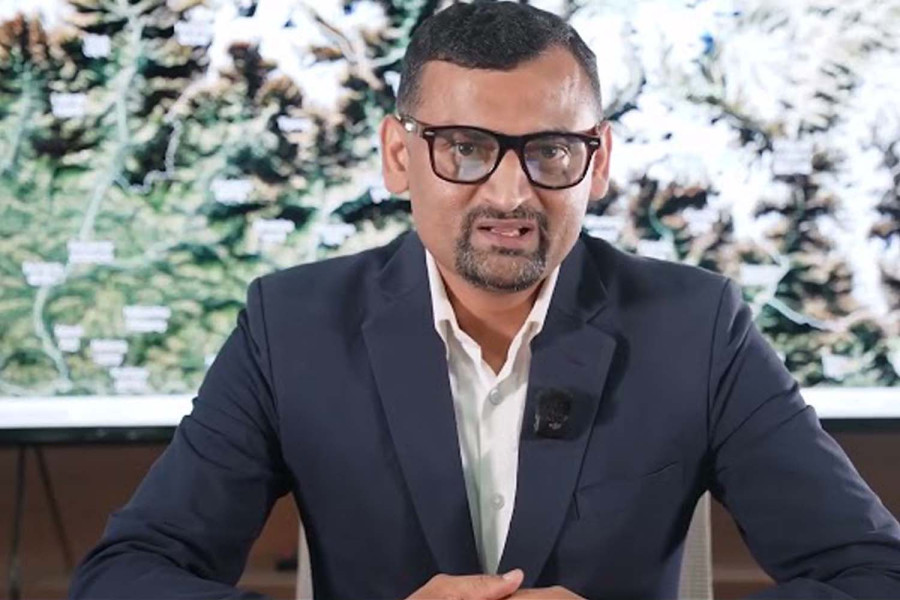
Biken K Dawadi
This year, celebration of Nepal’s biggest festival Dashain was affected by heavy rainfall across the country. While vehicular movements peak during the festive season, the losses due to monsoon-induced disaster incidents were minimal as compared to the monsoon last year, partially due to the somewhat accurate forecasting and improved disaster response. The Post’s Biken K Dawadi interviewed senior divisional hydrologist at the Department of Hydrology and Meteorology (DHM) Binod Parajuli to discuss the limits and challenges to accurate rainfall and flood forecasting, modality of information dissemination and the reasons behind the improved response this year. Excerpts:
What are the current accuracies of the monsoon rainfall and flash flood forecasts issued by the DHM?
Currently, the DHM has a capability of forecasting a yes/no event, i.e., whether it will rain or not, with an accuracy of 90 percent. As for the capability to forecast quantitative or qualitative intensity of rainfall, we predict with 70 percent accuracy. This means, when we forecast 50 mm rainfall, the rainfall might occur in the range of 40-60 mm. Our models allow us to forecast the rainfall for three days after any certain day. We depend on these forecasts and calculate the chances of floods by integrating factors such as housing density around the river and the speed of water flow.
What gaps limit forecasting capabilities?
The primary challenge to increasing the accuracy of rainfall forecasting is the complex topography of Nepal. Our forecast method is based on internationally developed models, which are augmented by our calibration and validation. As such, the models fail to adequately capture the topography and ground conditions.
Any model used in such a way is improved by input data. If we feed it more long-term data as well as real-time data, the model is more accurate in forecasting the chances and intensity of rainfall. However, we do not have sufficient data points to feed to the model, compromising our accuracy.
In addition, the network density of our observation stations is not adequate. We do not collect enough data from remote areas where the vulnerability of disasters might be high. We have not been able to assimilate data from such regions into our models.
Is the department sufficiently funded and equipped to carry out its mandate?
No, we still lack sufficient human resources to carry out our work during monsoon and infrastructure to improve the accuracy of our forecasts. To improve such capabilities, we need more funding.
What are its human resource and infrastructure needs?
Current human resources at the DHM is enough for most of the year. But we are severely short-staffed in terms of the number of experts during monsoon season. We need localised experts in various regions of the country to improve our forecasting accuracy. In the past seven years, we have increased the number of staff but we are still short of the optimal number. For example, the number of employees in the Flood Forecasting Division has reached around 12, which is still inadequate but an improvement from the 2-3 members five or six years ago.
In terms of infrastructure, we are operating at a bare minimum. There are around 500 weather observation stations across the country, out of which around 400 are automated. There are around 250 hydrological observation stations, of which around 200 are automated. We need double the existing number. We also need to transform all of the manual observation stations into automated ones.
What are the steps involved in the dissemination of information about rainfall and floods?
We use various tools and technologies to first forecast rainfall and floods. Through the existing station network, we can forecast up to three days of rainfall across the country. This forecast is first updated in the bulletin that we publish on the DHM’s official website.
Within minutes of updating the forecast on the website, we relay the information to various stakeholders, including the National Disaster Risk Reduction and Management Authority (NDRRMA), through a common communication platform. When we predict disaster incidents, we consult with the NDRRMA for confirmation on further steps.
When we get confirmation about the forecasted disaster incident from the NDRRMA, we inform all stakeholders about the probable incident. Then we publish the information on our social media handles. We are particularly active on X (formerly Twitter) and Facebook.
Then we forward the information to state-owned news media such as Nepal Television and Rastriya Samachar Samiti for further reach. We also release a press briefing every morning to elaborate on the bulletin from the previous day.
How are early warnings communicated to the vulnerable communities?
Generally, we have our toll free number 1155 through which individuals can get information about the forecasted weather in their particular areas. In addition, we also send mass SMS to the people in the areas where floods are forecasted. For example, we sent around 5.4 million SMS from Saturday morning to Sunday morning after we forecasted heavy rainfall across the country.
The department’s forecasting, as well as use of social media to disseminate information has improved this year. What are you doing differently?
The general public consumes most of its information through social media platforms. We realised the importance of these platforms in disseminating information in previous years. Over the past eight months, we worked with a number of media experts to improve the clarity and directness of our statements. Our goal was to make the statements and alert more effective in averting losses from monsoon-induced disasters.
We also increased our use of videos to disseminate information. We developed and produced videos and published them on various social media platforms, which increased our audience reach. Through the short videos we were also able to improve the understanding of the general public on technical terms related to rainfall and monsoon-induced disasters.
What advancements are being made in integrating new technologies into Nepal’s hydrological and meteorological models?
We have not been able to integrate the latest technologies in forecasting into our models. Our models are not updated enough to incorporate technological advancements such as machine learning and Artificial Intelligence. Our advancement till date is the development of decision support systems, which are full-fledged operational.
How has climate change impacted the rainfall patterns and forecasting accuracy?
We cannot directly claim that climate change has changed our rainfall patterns and forecasting accuracy. There are multiple other factors, including urbanisation and changed forest covers, which has brought about the change in these indicators.
However, logically, climate change has had an effect on our rainfall patterns and forecasting accuracy. We use long-term data to forecast the events of the future. As such, past data should be able to provide us with a tentative forecast of rainfall patterns. But such data have not been able to predict our rainfall in the past few years. Even glocal studies indicate that climate change has produced visible changes in rainfall patterns across the world. It has changed precipitation, intensity and duration of rainfall. In addition, it has decreased the groundwater table. All of these visible impacts of climate change have affected the rainfall pattern of Nepal and decreased our forecasting accuracy.
How has the preparedness and response this monsoon been different from previous years?
As compared to last year, the DHM’s responsibility remains the same. Of course, there have been some improvements from last year. But such is the case every year. We have additional observation stations, added experience and improved expertise but the modality remains the same. We have certainly improved the response methods as highlighted by our increased use of social media platforms and SMS alerts. We also reflected on our mistakes from last year and improved our approach to forecasting and information dissemination.
As for the NDRRMA, it too has learnt from its mistakes from last year. They too have improved their preparations for monsoon-induced disasters.
We also need to factor in the nature of rainfall this year as compared to last year. Last year, the most affected areas were in the hilly and mountainous regions where response and relief efforts are difficult to carry out. This resulted in high casualties and losses. This year, the most affected regions are mostly in the Tarai belt and, even in hilly areas, in areas where response and relief efforts were easier.
How has the change in government affected the disaster response?
We have observed better leadership in disaster response through timely action. Be it the prime minister’s timely address to the nation or the various risk-averting decisions, the government has taken urgent actions to avert losses from disaster incidents. Steps such as halting vehicular movements in sensitive areas and flights during heavy rainfall have helped minimise losses.
In addition, we have observed an improved response from the local governments. We saw local units make public announcements, discouraging travel. Last year, in the absence of such efforts, some individuals ventured outside their homes only to meet with accidents.




 16.12°C Kathmandu
16.12°C Kathmandu
